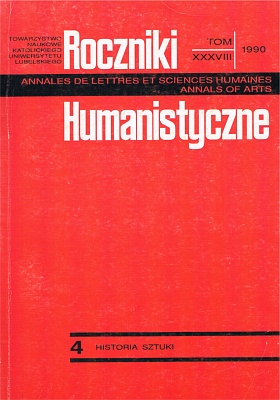Wooden Orthodox Churches in Świerszczów against the Background of Greek Catholic Architecture from the 18th to the 2nd Half of the 19th Century in the Former Chełm District
Abstract
In the village of Świerszczów in the former Chełm district (at present Chełm voievodship) the following wooden Orthodox churches functioned there: not preserved, conventionally defined as Orthodox church I (mentioned for the first time in 1510 − Orthodox, from 1596 on as Greek Catholic, demolished after 1797) and Orthodox church II − preserved (erected in 1801, initially as Uniate church, from 1875 as Orthodox and from 1921 as Roman-Catholic). Orthodox I was triple with a belfry above the porch. In the region under investigation this kind of view and mass were commonly employed in the wooden Orthodox architecture until ca. the 1750s. From the half of the 18th cent. they started to construct triple Orthodox churches with a detached belfry; this type of church was most often used till ca. 1915. Orthodox church II in Świerszczów was built in one-dimensional plan. In the same plan, earlier in 1728, the Orthodox church in Czerniejów was built. The one-dimensional arrangement did not occur in the traditional Orthodox architecture (except in buildings of a lower rank, eg chapels), similarly to two--dimensional plan. They were, however, characteristic of Latin architecture. In the 2nd half of the 18th century a few two-dimensional Orthodox churches were built (in Pniówno, Depultycze, Czułczyce II and Swierze III, Rydza). The latter three could have one-dimensional plan. Generally, from the 1750s to the 1850s 36 wooden Orthodox churches were built in the former Chełm district, of which 7 in other than three-dimensional plans.
We notice some essential changes in the arrangement and furnishings of the churches interior in relation to traditional Eastern realization. It was Zamość Council (1720) which played a key role here, because it permitted to unveil the main altar. The result of which was a new arrangement of the east part of the church. The analysis of the sources proves that in the region under investigation they did not dare to unveil the altar part completely: Instead of iconostas they employed a wooden partition reaching half of the bulding’s height (Czerniejów) or filling the wheol space (Świerszczów II). The main altar was placed in front of the partition (or built in it) and on both sides there were side altars; there was no altar behind the partition. There were icons hanging no the altars whose arrangement was identical with the arrangement of the lowest row of iconostas (complete, arranged in five rows). In such „iconostas” there were no czar’s or deacon’s gates. In the nave there were, alien to Eastern tradition, pulpit, confessional and benches. Even a rough analysis of the interior of the churches from Włodzimierz diocesis shows that Latin influences there were considerably weaker than in the part of Chełm diocesis under investigation, especially as far as the realization of the east part is concerned. And so: iconostas with the czar’s and deacon’s gates had only three rows; there was an altar behind it, the arrangement of the main altar did not differ. One may draw a conclusion that the farther eastward the stronger Latin influence was.
In the former Chełm district Latin influences were particularly strong in the 2nd half of the 18th century. We can observe this proces up to the 1840s, when the czar’s authorities took the first steps in order to abolish the Greek Catholic rite. The brick architecture was more receptive to new patterns, because Latin influences were apparent not only in the interior but also in views, contrary to wooden architecture which used traditional plans and changes in the interior. One has to emphasize that prominent buildings were erected mainly at the suggestion of bishops who were proponents of the union. These buldings-Orthodox churches (eg in Chełm) thoroughly dominated Latin forms (not only as far as interiors go but also views of the Latin cross, ellipses, etc.). Actually, they resemble baroque and rococo churches.
Copyright (c) 1990 Roczniki Humanistyczne

This work is licensed under a Creative Commons Attribution-NonCommercial-NoDerivatives 4.0 International License.





